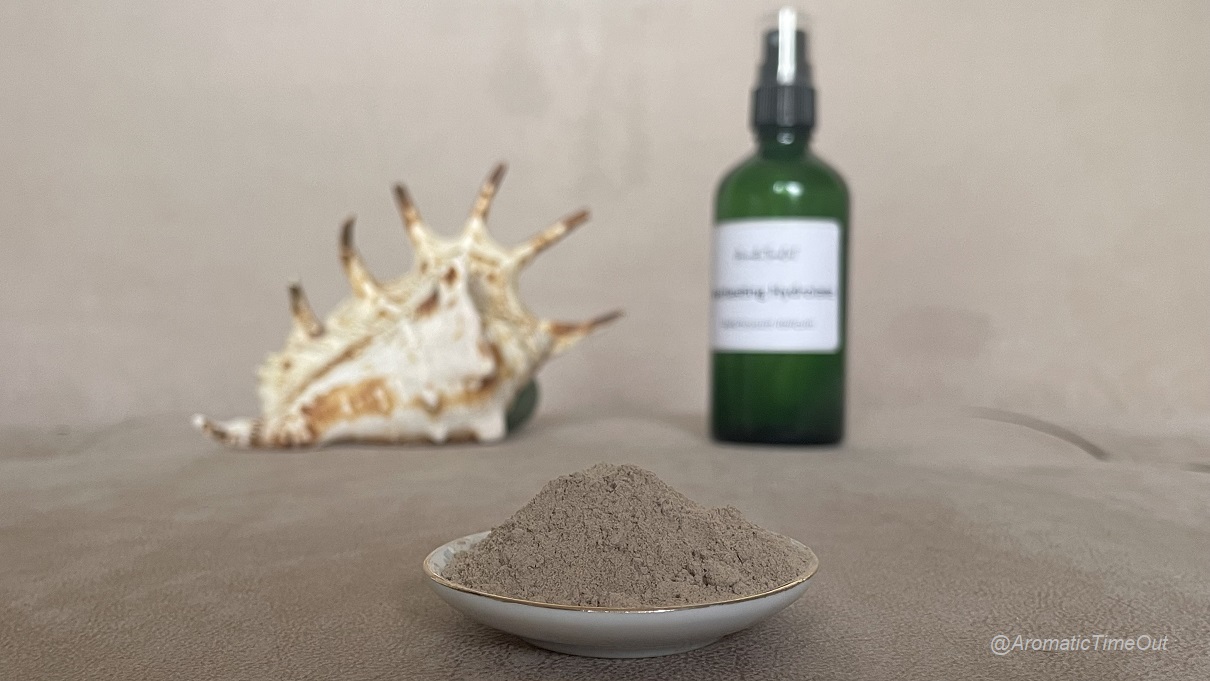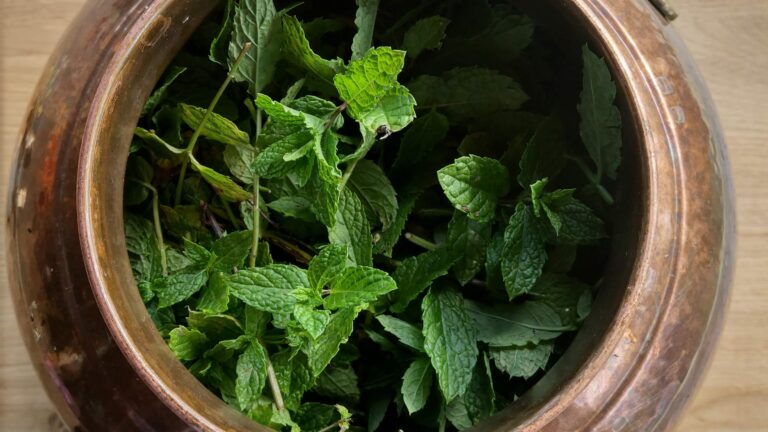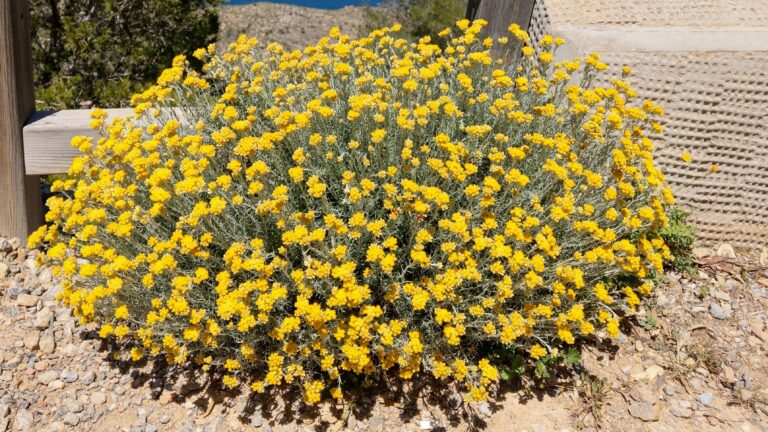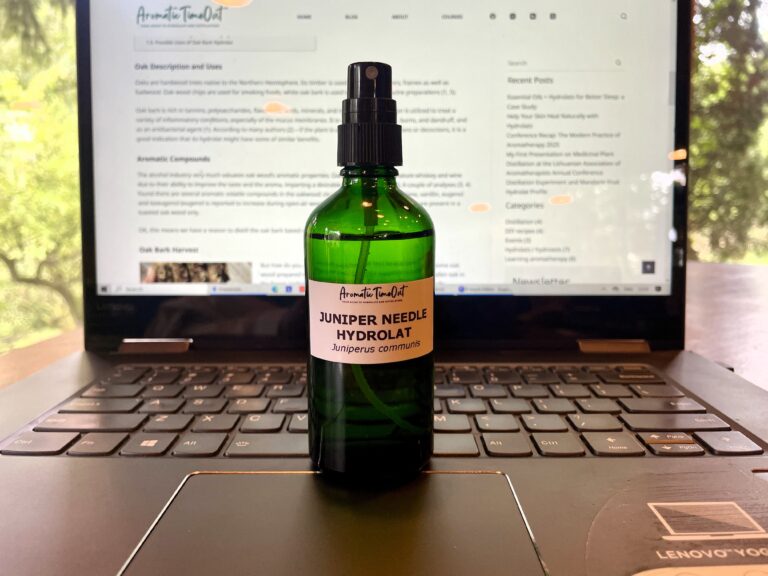Crazy Simple 2-Ingredient DIY Facial Cleanser
The minimalistic approach to skincare is gaining popularity. People choose to use fewer products with fewer ingredients and often experiment with DIY recipes. Hydrolats are a true star here due to their versatility.
Today I’m going to show an easy-to-make facial cleanser with only 2 ingredients. You can make it in seconds. This cleanser removes excess sebum, dirt, and makeup (even the waterproof). It also gently exfoliates the skin without disrupting its natural protective layer. In fact, it leaves a very unique velvety feeling on the skin. I like it a lot!
You will also find a video at the end of this article.
How to make a minimalistic facial cleanser?
Only 2 ingredients needed:
- ~7 ml Your favorite hydrolate
- ~1/3-1/2 tsp. of Rhassoul (Ghassoul) clay powder (INCI: Moroccan lava clay)
INSTRUCTIONS
The single portion to be used right away. Put ~1/3-1/2 tsp. of Rhassoul clay powder into a small bowl, pour or spray it with the hydrolate and simply mix everything thoroughly. Add more hydrosol if needed to make the desired consistency. Make it more watery if you only want to cleanse the skin. Make it thicker if you want a more exfoliating effect.
In fact, you can make this single portion of cleanser directly in your palm instead of a bowl. Can it be any simpler?
Other liquids can be used instead of or in a mixture with hydrosol: tea, herbal decoction, coconut milk, goat’s milk, aloe vera juice or gel, mineral or spring water, etc.
If you like you can use a different hydrolate each day because you are making only a single portion of cleanser each time. This gives you the freedom to experiment and find the best combination for your skin.
METHOD OF USE
Gently massage the cleanser onto your face, neck, and decollete area for a minute or two. If it gets too sticky – simply spray more hydrosol directly on your skin. Rince and enjoy the fresh feeling of your skin!
Making a stock bottle. Put 1 part of clay powder and 3-4 parts of hydrolate in a sterilized bottle. Shake well to combine the ingredients. Shake before using too.
Keep it in a cool place and use it within a week to avoid the possibility of bacterial growth. I do not recommend using any other liquids other than hydrolates to make a stock bottle. They are the most stable and are less prone to going bad quickly.
As always – test a product on a small patch of your skin first and wait for a few hours or a day. If you have a reaction – don’t use it.
Bonus Recipes: Shampoo and Body Wash
Mix rhassoul clay powder with hydrolate to a paste-like consistency to make a face mask. Keep it on for 5 minutes or more then rinse. Important – never let the mask dry. Spray more hydrosol directly onto the face to keep it moist enough.
Mix rhassoul clay powder with hydrolate to a shampoo-like consistency and wash your hair and body.
What is Rhassoul (Ghassoul) Clay and Why Use It?
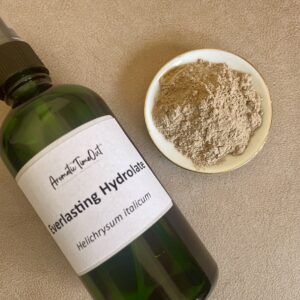 Rhassoul, like other clays, is rich in minerals that are readily available for our skin to absorb.
Rhassoul, like other clays, is rich in minerals that are readily available for our skin to absorb.
This clay is used in cleaning the skin and hair, even though it has no component that is a detergent. Rhassoul is unique because its absorption power is 4 times higher than that of coal. It absorbs the excess sebum and dirt without stripping the skin of its natural protection layer. It does not foam but cleanses the skin in its own unique way. You have to experience that to know what I’m talking about.
Rhassoul clay is mined exclusively in Morocco. Its name “ghassoul” (or “rhassoul”) comes from the Arabic word “rhassala”, which means “to wash”. For centuries, people in Morocco and the Mediterranean region have used it instead of shampoo and soap. Today, SPA centers and body care brands are incorporating it into their rituals, treatments, and products.
Choosing hydrolats based on skin condition
I’m not a fan of categorizing hydrosols according to skin type. Based on my experience, I cannot say something like “This hydrosol is good for oily skin, so avoid using it on dry skin” or vice versa. Hydrolates are very gentle and versatile substances; therefore you may choose them according to their aroma and your liking. All of them help hydrate, tone, calm the skin and help balance its pH.
There are, however, some recommendations based on the current condition of the skin:
- Mature skin: everlasting (Helichrysum italicum), geranium spp. (Pelargonium graveolens), Frankincense spp. (Boswellia serrata; sacra), rose (Rosa damascene).
- Prone to inflammatory conditions: lavender (Lavandula angustifolia), everlasting (Helichrysum italicum), yarrow (Achillea milefolium), German chamomile (Matricaria chamomilla), calendula (Calendula officinalis).
- Small wounds, scratches, scars: compfrey (Symphytum officinale), yarrow (Achillea milefolium), lavender (Lavandula angustifolia), German chamomile (Matricaria chamomilla), calendula (Calendula officinalis).
- Sunburn: lavender (Lavandula angustifolia), rose (Rosa damascene), German chamomile (Matricaria chamomilla), everlasting (Helichrysum italicum).
- For a cooling effect: mint spp. (Mentha spicata, piperita), German chamomile (Matricaria chamomilla), rose (Rosa damascene).
Hydrosols for the hair: rosemary (Salvia rosmarinus), German chamomile (Matricaria chamomilla), nettle (Urtica dioica).
Choosing hydrolats based on emotional aspects
The aromas interact with the limbic system, which controls our emotions. Therefore, we can intentionally choose the aroma to modify our mood or help us reach the desired emotional state. Here is a short list of how to choose hydrolats for that purpose.
- Relaxing, calming hydrolates: lavender (Lavandula angustifolia), lemon balm (Melissa officinalis), Roman chamomile (Anthemis nobilis/ Chamaemelum nobile), rose (Rosa damascene), Frankincense spp. (Boswellia serrata; sacra), everlasting (Helichrysum italicum).
- Energizing hydrolates: mint spp. (Mentha spicata, piperita), Rosemary (Salvia rosmarinus), Juniper berries or/and branches (Juniperus communis).
- Uplifting hydrolates: everlasting (Helichrysum italicum), rose (Rosa damascene), pine spp. (Pinus sylvestris, mugo).
- Meditative, spiritual hydrolates: Frankincense spp. (Boswellia serrata; sacra), geranium spp. (Pelargonium graveolens), spruce (Picea abies).
This list is also helpful in choosing hydrosols for the evening or morning procedures.
Your personal perception of the aromas may not correspond to the above-listed emotional states. That’s all right – follow your intuition in that case, not my list.
A single hydrosol or a mixture of several may be used. Improvise and find out your favorite synergies.
If you are a total beginner and have never used hydrosol before, I would probably recommend starting with one of these: lavender (Lavandula angustifolia), German chamomile (Matricaria chamomilla), Frankincense spp. (Boswellia serrata; sacra) or rose (Rosa damascene).
Takeaway
You can make a lot of skincare products yourself with only two simple yet remarkable ingredients: Rhassoul (Ghassoul) clay powder and hydrolate. Combine them in different ratios and make yourself a facial cleanser, mask, exfoliant, shampoo or bodywash.
Rhassoul clay is rich in minerals. Hydrolate moisturizes, tones your skin, and balances its pH. The combination of both will result in a wonderful velvety feeling on your clean skin.
You can make a single portion of face cleanser in literally seconds. Furthermore – you can customize your product by using different hydrolates (hydrosols) each time. This gives you the freedom to experiment and find the best combination for your skin.
Recourses
https://www.theclaycure.co.uk/theclaycure/beauty/health/recipes/recipes-with-rhassoul/
https://aromata.lt/en/shop/821/ghassoul-rhassoul-clay
https://aromata.lt/lt/75/apie-kosmetinius-molius-ir-unikaluji-gasula
https://www.aroma-zone.com/info/fiche-technique/rhassoul-du-maroc-aroma-zone

